This is an old revision of this page, as edited by Netoholic (talk | contribs) at 15:23, 14 April 2018 (→Trump administration: sources). The present address (URL) is a permanent link to this revision, which may differ significantly from the current revision.
Revision as of 15:23, 14 April 2018 by Netoholic (talk | contribs) (→Trump administration: sources)(diff) ← Previous revision | Latest revision (diff) | Newer revision → (diff)

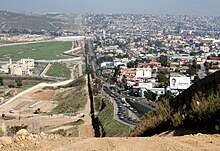
The Mexico–United States barrier is a series of walls and fences along the Mexico–United States border aimed at preventing illegal crossings from Mexico into the United States. The barrier is not one contiguous structure, but a grouping of relatively short physical walls, secured in between with a "virtual fence" which includes a system of sensors and cameras monitored by the United States Border Patrol. As of January 2009, U.S. Customs and Border Protection reported that it had more than 580 miles (930 km) of barriers in place. The total length of the continental border is 1,989 miles (3,201 km).
Background
Further information: Mexico–United States border and Illegal immigration to the United States
The barriers were built from 1994 as part of three larger "Operations" to taper transportation of illegal drugs manufactured in Latin America and immigration: Operation Gatekeeper in California, Operation Hold-the-Line in Texas, and Operation Safeguard in Arizona.
97% of border apprehensions (foreign nationals who are caught being in the U.S. illegally) by the Border Patrol in 2010 occurred at the southwest border. The number of Border Patrol apprehensions declined 61% from 1,189,000 in 2005 to 723,840 in 2008 to 463,000 in 2010. The decrease in apprehensions may be due to a number of factors including, changes in U.S. economic conditions and border enforcement efforts. Border apprehensions in 2010 were at their lowest level since 1972. In December 2016 apprehensions were at 58,478, whereas in March 2017, there were 17,000 apprehensions, which was the fifth month in a row of decline.
The 1,954-mile (3,145 km) border between the United States and Mexico traverses a variety of terrains, including urban areas and deserts. The barrier is located on both urban and uninhabited sections of the border, areas where the most concentrated numbers of illegal crossings and drug trafficking have been observed in the past. These urban areas include San Diego, California and El Paso, Texas. As of August 29, 2008, the U.S. Department of Homeland Security had built 190 miles (310 km) of pedestrian border fence and 154.3 miles (248.3 km) of vehicle border fence, for a total of 344.3 miles (554.1 km) of fence. The completed fence is mainly in New Mexico, Arizona, and California, with construction underway in Texas.
U.S. Customs and Border Protection reported that it had more than 580 miles (930 km) of fence in place by the second week of January 2009. Work is still under way on fence segments in Texas and on the Border Infrastructure System in California.
As a result of the effect of the barrier, there has been a marked increase in the number of people trying to illegally cross areas which have no fence such as the Sonoran Desert and the Baboquivari Mountain in Arizona. Such illegal immigrants must cross 50 miles (80 km) of inhospitable terrain to reach the first road, which is located in the Tohono O'odham Indian Reservation.
Status


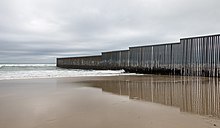

U.S. Representative Duncan Hunter, a Republican from California and the then-chairman of the House Armed Services Committee, proposed a plan to the House on November 3, 2005 calling for the construction of a reinforced fence along the entire United States–Mexican border. This would also have included a 100-yard (91 m) border zone on the U.S. side. On December 15, 2005, Congressman Hunter's amendment to the Border Protection, Anti-terrorism, and Illegal Immigration Control Act of 2005 (H.R. 4437) passed in the House. This plan called for mandatory fencing along 698 miles (1,123 km) of the 1,954-mile (3,145-kilometre) border. On May 17, 2006 the U.S. Senate proposed with Comprehensive Immigration Reform Act of 2006 (S. 2611) what could be 370 miles (600 km) of triple layered-fencing and a vehicle fence. Although that bill died in committee, eventually the Secure Fence Act of 2006 was passed by Congress and signed by President George W. Bush on October 26, 2006.
The government of Mexico and ministers of several Latin American countries condemned the plans. Rick Perry, Governor of Texas, also expressed his opposition saying that instead of closing the border it should be opened more and through technology, support legal and safe migration. The barrier expansion was also opposed by a unanimous vote by the Laredo, Texas City Council. Laredo's Mayor, Raul G. Salinas, defended his town's people by saying that the bill, which included miles of border wall, would devastate Laredo. He stated "These are people that are sustaining our economy by forty percent, and I am gonna close the door on them and put a wall? You don't do that. It's like a slap in the face." He hoped that Congress would revise the bill to better reflect the realities of life on the border.
Secure Fence Act
Main article: Secure Fence Act of 2006This section has multiple issues. Please help improve it or discuss these issues on the talk page. (Learn how and when to remove these messages)
|
H.R. 6061, the "Secure Fence Act of 2006", was introduced on September 13, 2006. It passed through the U.S. House of Representatives on September 14, 2006 with a vote of 283–138.
On September 29, 2006, by a vote of 80–19 the U.S. Senate confirmed H.R. 6061 authorizing, and partially funding the "possible" construction of 700 miles (1,125 km) of physical fence/barriers along the border. The very broad support implied that many assurances were made by the Administration – to the Democrats, Mexico, and the pro "Comprehensive immigration reform" minority among Republicans – that Homeland Security would proceed very cautiously. Secretary of Homeland Security Michael Chertoff, announced that an eight-month test of the virtual fence he favored would precede any construction of a physical barrier.
On October 26, 2006, President George W. Bush signed H.R. 6061 which was voted upon and passed by the 109th Congress of the United States. The signing of the bill came right after a CNN poll showed that most Americans "prefer the idea of more Border Patrol agents to a 700-mile (1,125-kilometer) fence." The Department of Homeland Security has a down payment of $1.2 billion marked for border security, but not specifically for the border fence.
As of January 2010, the fence project had been completed from San Diego, California to Yuma, Arizona. From there it continued into Texas and consisted of a fence that was 21 feet (6.4 m) tall and 6 feet (1.8 m) deep in the ground, cemented in a 3-foot (0.91 m)-wide trench with 5,000 psi (345 bar; 352 kg/cm²) concrete. There were no fatalities during construction, but there were 4 serious injuries with multiple aggressive acts against building crews. There was one reported shooting with no injury to a crew member in the Mexicali region. All fence sections are south of the All-American Canal, and have access roads giving border guards the ability to reach any point easily, including the dunes area where a border agent was killed 3 years prior and is now sealed off.
The Republican Party's 2012 platform stated that "The double-layered fencing on the border that was enacted by Congress in 2006, but never completed, must finally be built." The Secure Fence Act's costs were estimated at $6 billion, more than the Customs and Border Protection's entire annual discretionary budget of $5.6 billion. The Washington Office on Latin America noted on its Border Fact Check site in 2013 that the cost of complying with the Secure Fence Act's mandate was the reason it had not been completely fulfilled.
Rethinking the expansion
In January 2007, incoming House Majority Leader Steny H. Hoyer (D-MD) announced that Congress would revisit the fence plan, with committee chairs holding up funding until a comprehensive border security plan was presented by the United States Department of Homeland Security. Then, by the end of January, the Republican senators from Texas, John Cornyn and Kay Bailey Hutchison, advocated revising the plan, as well.
The REAL ID Act, attached as a rider to a supplemental appropriations bill funding the wars in Iraq and Afghanistan, decreed, "Not withstanding any other provision of law, the Secretary of Homeland Security shall have the authority to waive all legal requirements such Secretary, in such Secretary's sole discretion, determines necessary to ensure expeditious construction of the barriers and roads." Secretary Chertoff used his new power to "waive in their entirety" the Endangered Species Act, the Migratory Bird Treaty Act, the National Environmental Policy Act, the Coastal Zone Management Act, the Clean Water Act, the Clean Air Act, and the National Historic Preservation Act to extend triple fencing through the Tijuana River National Estuarine Research Reserve near San Diego. The Real ID Act further stipulates that the Secretary's decisions are not subject to judicial review, and in December 2005 a federal judge dismissed legal challenges by the Sierra Club, the Audubon Society, and others to Chertoff's decision.
Secretary Chertoff exercised his waiver authority on April 1, 2008. In June 2008, the U.S. Supreme Court declined to hear the appeal of a lower court ruling upholding the waiver authority in a case filed by the Sierra Club. In September 2008 a federal district court judge in El Paso dismissed a similar lawsuit brought by El Paso County, Texas.
By January 2009, U.S. Customs and Border Protection and Homeland Security had spent $40 million on environmental analysis and mitigation measures aimed at blunting any possible adverse impact that the fence might have on the environment. On January 16, 2009, DHS announced it was pledging an additional $50 million for that purpose, and signed an agreement with the U.S. Department of the Interior for utilization of the additional funding.
Expansion freeze
On March 16, 2010, the Department of Homeland Security announced that there would be a halt to expand the "virtual fence" beyond two pilot projects in Arizona.
Contractor Boeing Corporation had numerous delays and cost overruns. Boeing had initially used police dispatching software that was unable to process all of the information coming from the border. The $50 million of remaining funding would be used for mobile surveillance devices, sensors, and radios to patrol and protect the border. At the time, the Department of Homeland Security had spent $3.4 billion on border fences and had built 640 miles (1,030 km) of fences and barriers as part of the Secure Border Initiative.
Local efforts
See also: Texas Virtual Border WatchPiecemeal fencing has also been established. In 2005, under its president, Ramón H. Dovalina, Laredo Community College, located on the border, obtained a 10-foot fence built by the United States Marine Corps. The structure was not designed as a border barrier as such but was intended to divert smugglers and illegal immigrants to places where the authorities can halt entrance into the U.S.
Trump administration
Further information: Executive Order 13767 See also: Immigration policy of Donald Trump and 2017 Mexico–United States diplomatic crisis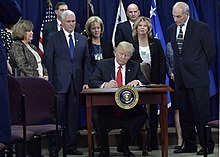
Throughout his 2016 presidential campaign, Donald Trump called for the construction of a much larger and fortified wall, and claimed Mexico will pay for its construction, estimated at $8 to $12 billion, while others state there are enough uncertainties to drive up the cost between $15 to $25 billion. In January 2017, Mexican President Enrique Peña Nieto said the country would not pay for the wall. On January 25, 2017, the Trump administration signed a Border Security and Immigration Enforcement Improvements Executive Order, 13767 to commence extending the border wall.
Trump had planned to meet Nieto at the White House on January 27, 2017 to discuss topics including border security, and announced the U.S. would impose a 20% tariff on Mexican goods to effectively pay for the wall. Peña Nieto gave a national televised address confirming they would not pay, adding "Mexico doesn't believe in walls", and cancelled the meeting.
In March 2017, the Trump administration submitted a budget amendment for fiscal year 2017 that includes a $3 billion continuing budget for border security and immigration enforcement. Trump's FY 2018 Budget Blueprint increases discretionary funds for the Department of Homeland Security (DHS) by $2.8 billion (to $44.1 billion). The DHS Secretary John F. Kelly told the Senate Homeland Security and Governmental Affairs Committee during a hearing the Budget Blueprint "includes $2.6 billion for high-priority border security technology and tactical infrastructure, including funding to plan, design and construct the border wall".
U.S. Senator Claire McCaskill (D-MO) said during a hearing while Americans want a secure border, she has "not met anyone that says the most effective way is to build a wall across the entirety of our southern border. The only one who keeps talking about that is President Trump."
Trump proposed in a White House meeting that the wall should be covered with solar panels, claiming that this would generate revenue and improve its appearance. On June 21, 2017, Trump told a rally in Cedar Rapids Iowa that he is working on ways "Mexico will have to pay much less money", saying that the wall would be a "solar wall" that could "create energy and pay for itself". Trump also touted a report he had seen on Fox News that cited a study by the Center for Immigration Studies in which it claimed that a wall along the Mexican border could save taxpayers $64 billion by reducing crime and welfare costs for undocumented immigrants over the next 10 years. In August 2017, while speaking at a rally in Phoenix, Arizona, Trump stated he will close down the U.S. government if necessary to force Congress to pay for the wall. As of the end of 2017, Mexico has not entered into any agreement to pay for any amount of the wall, no new tariffs on Mexican goods have been considered by the U.S. Congress, and Congress has not appropriated funding for a wall.
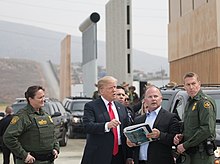
On September 12, 2017, the United States Department of Homeland Security issued a notice Acting Secretary of Homeland Security Elaine Duke would be waiving "certain laws, regulations and other legal requirements" to begin construction of the new wall near Calexico, California. The waiver allows the Department of Homeland Security to bypass the National Environmental Policy Act, the Endangered Species Act, the Clean Water Act, the Clean Air Act, the National Historic Preservation Act, the Migratory Bird Treaty Act, the Migratory Bird Conservation Act, the Archaeological Resources Protection Act, the Safe Drinking Water Act, the Noise Control Act, the Solid Waste Disposal Act, the Antiquities Act, the Federal Land Policy and Management Act, the Administrative Procedure Act, the Native American Graves Protection and Repatriation Act, and the American Indian Religious Freedom Act.
In September 2017, the U.S. government announced the start of construction of eight prototype barriers made from concrete and other materials. With the exception of the small samples, no further wall construction has started beyond what was already planned during the Obama administration.
Controversy
The barrier has been criticized for being easy to get around. Some methods include digging under it (sometimes using complex tunnel systems), climbing the fence (using wire cutters to remove barbed-wire) or locating and digging holes in vulnerable sections of the wall. Many Latin-Americans have also traveled by boat through the Gulf of Mexico or the Pacific Coast.
Divided land
Tribal lands of three indigenous nations would be divided by the proposed border fence.
On January 27, 2008, a Native American human rights delegation in the United States, which included Margo Tamez (Lipan Apache-Jumano Apache) and Teresa Leal (Opata-Mayo) reported the removal of the official International Boundary obelisks of 1848 by the U.S. Department of Homeland Security in the Las Mariposas, Sonora-Arizona sector of the Mexico–U.S. border. The obelisks were moved southward approximately 20 meters, onto the property of private landowners in Sonora, as part of the larger project of installing the 18-foot (5.5 m) steel barrier wall.
The proposed route for the border fence would divide the campus of the University of Texas at Brownsville into two parts, according to Antonio N. Zavaleta, a vice president of the university. There have been campus protests against the wall by students who feel it will harm their school. In August 2008, UT-Brownsville reached an agreement with the U.S. Department of Homeland Security for the university to construct a portion of the fence across and adjacent to its property. The final agreement, which was filed in federal court on Aug 5 and formally signed by the Texas Southmost College Board of Trustees later that day, ended all court proceedings between UTB/TSC and DHS. On August 20, 2008, the university sent out a request for bids for the construction of a 10-foot (3.0 m) high barrier that incorporates technology security for its segment of the border fence project. The southern perimeter of the UTB/TSC campus will be part of a laboratory for testing new security technology and infrastructure combinations. The border fence segment on the UTB campus was substantially completed by December 2008.
Hidalgo County
In the spring of 2007 more than 25 landowners, including a corporation and a school district, from Hidalgo and Starr County in Texas refused border fence surveys, which would determine what land was eligible for building on, as an act of protest.
In July 2008, Hidalgo County and Hidalgo County Drainage District No. 1 entered into an agreement with the U.S. Department of Homeland Security for the construction of a project that combines the border fence with a levee to control flooding along the Rio Grande. As of September 2008, construction of two of the Hidalgo County fence segments was under way, with five more segments scheduled to be built during the fall of 2008. The Hidalgo County section of the border fence was planned to constitute 22 miles (35 km) of combined fence and levee.
Mexico's condemnations
See also: Mexico–United States relations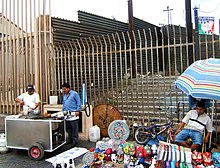
In 2006, the Mexican government vigorously condemned the Secure Fence Act of 2006. Mexico has also urged the U.S. to alter its plans for expanded fences along their shared border, saying that it would damage the environment and harm wildlife.
In June 2007, it was announced that a section of the barrier had been mistakenly built from 1 to 6 feet (2 meters) inside Mexican territory. This will necessitate the section being moved at an estimated cost of over $3 million (U.S.).
In 2012, then presidential candidate of Mexico Enrique Peña Nieto was campaigning in Tijuana at the Playas de Monumental, less than 600 yards (550 m) from the U.S.–Mexico border adjacent to Border Field State Park. In one of his speeches he criticized the U.S. government for building the barriers, and asked for them to be removed. Ultimately, he mocked Ronald Reagan's "Tear down this wall!" speech from Berlin in 1987.
Migrant deaths
Main article: Migrant deaths along the Mexico–United States border
Between 1994 and 2007, there were around 5,000 migrant deaths along the Mexico–United States border, according to a document created by the Human Rights National Commission of Mexico, also signed by the American Civil Liberties Union. Between 43 and 61 people died trying to cross the Sonoran Desert from October 2003 to May 2004; three times that of the same period the previous year. In October 2004 the Border Patrol announced that 325 people had died crossing the entire border during the previous 12 months. Between 1998 and 2004, 1,954 persons are officially reported to have died along the Mexico–U.S. border. Since 2004, the bodies of 1,086 migrants have been recovered in the southern Arizona desert.
U.S. Border Patrol Tucson Sector reported on October 15, 2008 that its agents were able to save 443 undocumented immigrants from certain death after being abandoned by their smugglers, during FY 2008, while reducing the number of deaths by 17% from 202 in FY 2007 to 167 in FY 2008. Without the efforts of these agents, hundreds more could have died in the deserts of Arizona. According to the same sector, border enhancements like the wall have allowed the Tucson Sector agents to reduce the number of apprehensions at the borders by 16% compared with fiscal year 2007.
Environmental impact

In April 2008, the Department of Homeland Security announced plans to waive more than 30 environmental and cultural laws to speed construction of the barrier. Despite claims from then Homeland Security Chief Michael Chertoff that the department would minimize the construction's impact on the environment, critics in Arizona, New Mexico, and Texas, asserted the fence endangered species and fragile ecosystems along the Rio Grande. Environmentalists expressed concern about butterfly migration corridors and the future of species of local wildcats, the ocelot, the jaguarundi, and the jaguar.
U.S. Customs and Border Protection (CBP) conducted environmental reviews of each pedestrian and vehicle fence segment covered by the waiver, and published the results of this analysis in Environmental Stewardship Plans (ESPs). Although not required by the waiver, CBP has conducted the same level of environmental analysis (in the ESPs) that would have been performed before the waiver (in the "normal" NEPA process) to evaluate potential impacts to sensitive resources in the areas where fence is being constructed.
ESPs completed by CBP contain extremely limited surveys of local wildlife. For example, the ESP for border fence built in the Del Rio Sector included a single survey for wildlife completed in November 2007, and only "3 invertebrates, 1 reptile species, 2 amphibian species, 1 mammal species, and 21 bird species were recorded." The ESPs then dismiss the potential for most adverse effects on wildlife, based on sweeping generalizations and without any quantitative analysis of the risks posed by border barriers. Approximately 461 acres (187 ha) of vegetation will be cleared along the impact corridor. From the Rio Grande Valley ESP: "The impact corridor avoids known locations of individuals of Walker's manioc and Zapata bladderpod, but approaches several known locations of Texas ayenia. For this reason, impacts on federally listed plants are anticipated to be short-term, moderate, and adverse." This excerpt is typical of the ESPs in that the risk to endangered plants is deemed short-term without any quantitative population analysis.
By August 2008, more than 90% of the southern border in Arizona and New Mexico had been surveyed. In addition, 80% of the California/Mexico border has been surveyed.

About 100 species of plants and animals, many already endangered, are threatened by the wall, including the jaguar, ocelot, Sonoran pronghorn, Mexican wolf, a pygmy owl and the Quino checkerspot butterfly. According to Scott Egan of Rice University, a wall can create a population bottleneck, increase inbreeding, and cut off natural migration routes as well as range expansion.
An initial 75 mile wall for which U.S. funding has been requested on the nearly 2,000 mile border would pass through the Tijuana Slough National Wildlife Refuge in California, the Santa Ana National Wildlife Refuge and Lower Rio Grande Valley National Wildlife Refuge in Texas, and Mexico's Cabeza Prieta National Wildlife Refuge and El Pinacate y Gran Desierto de Altar Biosphere Reserve, which is a UNESCO World Heritage Site that the U.S. is bound by global treaty to protect. The U.S. Customs and Border Patrol (CBP) plans to build the wall using the REAL ID Act to avoid the process of making environmental impact statements, a strategy devised by Michael Chertoff during the Bush administration. Reuters said, "The Real ID Act also allows the secretary of Homeland Security to exempt CBP from adhering to the Endangered Species Act" which would otherwise prohibit construction in a wildlife refuge.
See also
- 2017 Mexico–United States diplomatic crisis
- Guatemala–Mexico border
- Immigration reduction in the United States
- List of Mexico–United States border crossings
- List of walls
- Open border
- Salt of the Earth
- Tortilla Wall
- United States Border Patrol interior checkpoints
References
- Garcia, Michael John (November 18, 2016). Barriers Along the U.S. Borders: Key Authorities and Requirements (PDF). Washington, DC: Congressional Research Service. Retrieved December 9, 2016.
- ^ "The Border Fence". NOW on PBS.
- ^ U.S. Plans Border ‘Surge’ Against Any Drug Wars The New York Times, January 7, 2009.
- McPhail, Weldon, Assistant Director, Administration of Justice Issues, Dennise R. Stickley, Evaluator, David P. Alexander, Social Science Analyst: Washington, DC, Appendix I:1; Michael P. Dino, Evaluator-in-Charge, James R. Russell, Evaluator: LA Regional Office, Appendix I:2; "Border Control: Revised Strategy Is Showing Some Positive Results". Subcommittee on Information, Justice, Transportation and Agriculture, Committee on Government Operations, House of Representatives, December 29, 1994.
- Pike, John. "Operation Gatekeeper: Operation Hold-the-Line: Operation Safeguard".
- Sapp, Lesley (July 2011). Apprehensions by the U.S. Border Patrol: 2005–2010. Office of Immigration Studies, United States Department of Homeland Security (Washington, D.C.) Retrieved November 18, 2011
- ^ "U.S. Homeland Security secretary has 'elbow room' on building border wall". Homeland Preparedness News. April 5, 2017. Retrieved April 21, 2017.
- ^ "U.S. Customs and Border Protection". Cbp.gov. September 28, 2005. Retrieved March 27, 2010.
- ^ "Border Desert Proves Deadly For Mexicans". The New York Times. May 23, 2004.
- One Nation, Under Fire High Country News, February 19, 2007.
- "Hunter proposal for strategic border fencing passes House". 2005. Archived from the original on October 6, 2006. Retrieved October 10, 2006.
- "109th Congress Public Law 367". gpo.gov. Retrieved January 15, 2017.
{{cite web}}: Italic or bold markup not allowed in:|publisher=(help) - "Rechaza gobernador de Texas muro fronterizo" (in Spanish). Retrieved March 7, 2006.
- ^ James Rowley, "U.S.–Mexico Border Fence Plan Will Be 'Revisited' By Congress," Bloomberg January 17, 2007.
- Kahn, Carrie (July 8, 2006). "Immigration Debate Divides Laredo". NPR. Retrieved September 28, 2007.
- "ABC News: Bush Signs U.S.–Mexico Border Fence Bill". Archived from the original on November 21, 2007. Retrieved October 26, 2006.
{{cite web}}: Unknown parameter|dead-url=ignored (|url-status=suggested) (help) - "Bush OKs 700-mile (1,100 km) border fence". CNN.com. Archived from the original on October 27, 2006. Retrieved October 26, 2006.
- "2012 Republican Party Platform" (PDF). The Republican National Convention. Retrieved September 24, 2012.
- Weisman, Jonathan (September 30, 2006). "With Senate Vote, Congress Passes Border Fence Bill". The Washington Post.
- "Budget-in-Brief" (pdf). United States Department of Homeland Security. 2006.
- Isaacson, Adam. "A budget-busting proposal in the Republican platform". Border Facts: Separating Rhetoric from Reality.
- "Billing Code 4410-10 Department of Homeland Security" (PDF).
- "Narco News: Border Wall Battle: Bad News vs. Good News". narconews.com.
- Archibold, Randal C. (January 17, 2009). "Border Plan Will Address Harm Done at Fence Site". The New York Times. Retrieved March 27, 2010.
- ^ Hsu, Spencer S. (March 16, 2010). "Work to cease on 'virtual fence' along U.S.–Mexico border". The Washington Post.
- "Fence Protects College From Smugglers and illegals". San Antonio, Texas: KSAT-TV (ABC). April 14, 2005. Retrieved August 25, 2015.
- ^ "How realistic is Donald Trump's Mexico wall?". BBC News. January 26, 2016. Retrieved January 26, 2016.
- "President Trump moves ahead with wall, puts stamp on U.S. immigration, security policy". Reuters. Reuters. January 26, 2017. Retrieved January 26, 2017.
- "Here's how much Trump's border wall will cost". CNN. CNN. January 26, 2017. Retrieved January 31, 2017.
- PBS NewsHour Weekend full episode March 18, 2017 on YouTube at 4:18 of 22:29
- "Donald Trump: 'We will build Mexico border wall'". BBC News. January 26, 2016. Retrieved January 26, 2016.
- "Quien se mueve sí sale en la foto". Excelsior (in Spanish). March 7, 2016. Retrieved January 25, 2017.
- Davis, Julie Hirschfeld (January 25, 2017). "Trump Orders Mexican Border Wall to Be Built and Is Expected to Block Syrian Refugees". The New York Times. ISSN 0362-4331. Retrieved January 26, 2017.
- Reuters (January 26, 2017). "Trump seeks 20 percent tax on Mexico goods to pay for wall, crisis deepens". Reuters. Retrieved January 26, 2017.
{{cite web}}:|last=has generic name (help) - "Mexico: We will not pay for Trump border wall". BBC News. January 26, 2017. Retrieved January 26, 2017.
- CNN, Daniella Diaz. "Mexican president cancels meeting with Trump".
{{cite web}}:|last=has generic name (help) - ^ "Republicans skeptical about paying for wall as Trump releases budget". Washington Post.com. March 16, 2017.
- "In debate over how to protect Southwest border, no one size fits all solution". Homeland Preparedness News. April 4, 2017. Retrieved April 21, 2017.
- Solon, Olivia (June 8, 2017). "Trump's pitch for making the Mexico border wall 'beautiful': add solar panels". The Guardian. Retrieved June 8, 2017.
- CNN, Saba Hamedy,. "Trump: 'Solar wall' could 'pay for itself'". CNN. Retrieved September 12, 2017.
{{cite news}}:|last=has generic name (help)CS1 maint: extra punctuation (link) CS1 maint: multiple names: authors list (link) - Fredericks, Bob (March 13, 2018). "Trump says border wall will pay for itself". New York Post. Retrieved April 14, 2018.
- Boehm, Eric. "Trump Says the Border Wall Will Pay for Itself. It Won't". Reason.com. Reason. Retrieved April 14, 2018.
- Kessler, Glenn (March 16, 2018). "Does President Trump's border wall pay for itself?". The Washington Post. Retrieved April 14, 2018.
- "Trump touts Fox News report that border wall could pay for itself". thehill.com. March 13, 2018.
- ^ "Trump says he is willing to 'close government' to build Mexico wall". BBC News. August 23, 2017. Retrieved August 23, 2017.
- "Determination Pursuant to Section 102 of the Illegal Immigration Reform and Immigrant Responsibility Act of 1996, as Amended". Federal Register. September 12, 2017. Retrieved September 13, 2017.
- Hand, Mark (September 12, 2017). "Homeland Security waives environmental review for California border project". Think Progress. Retrieved September 13, 2017.
- Rafael Carranza (October 18, 2017). "A first look at 8 possible versions of President Donald Trump's border wall". The Arizona Republic. Retrieved October 19, 2017.
- "US–Mexico border wall prototype construction starts". BBC. September 27, 2017. Retrieved September 28, 2017.
- O'odham tell U.N. rapporteur of struggles Indian Country, October 31, 2005
- As Border Crackdown Intensifies, A Tribe Is Caught in the Crossfire Washington Post, September 15, 2006
- "Nogales Residents Say US is Building Border Wall on Mexico's Land – the narcosphere".
- "Monuments, Manifest Destiny, and Mexico". August 15, 2016.
- "Nogales Residents Say US is Building Border Wall on Mexico's Land". Narcosphere.narconews.com. Retrieved March 27, 2010.
- "Some Texans Fear Border Fence Will Sever Routine of Daily Life", New York Times, June 20, 2007
- Bids Requested for Fence Upgrade The University of Texas at Brownsville and Texas Southmost College, August 20, 2008
- Sieff, Kevin (December 12, 2008). "'Friendly Fence'". Brownsville Herald. Archived from the original on July 22, 2012. Retrieved March 27, 2010.
{{cite web}}: Unknown parameter|dead-url=ignored (|url-status=suggested) (help) - Roebuck, Jeremy (March 17, 2008). "Local: Hidalgo border fence suits head to court". Brownsville Herald. Archived from the original on July 22, 2012. Retrieved March 27, 2010.
{{cite web}}: Unknown parameter|dead-url=ignored (|url-status=suggested) (help) - Border wall in Hidalgo County moves forward Brownsville Herald, September 6, 2008
- "US border fences 'an eco-danger'". BBC News. July 31, 2007. Retrieved March 27, 2010.
- "Border Fence Built In Mexico By Mistake". CBS News. June 29, 2007.
- El Universal de Mexico (Spanish) Retrieved November 9, 2007
- "Border deaths of illegal migrants cause concern".
- New Matilda The Long Graveyard
- "CBP Border Patrol Announces Fiscal Year 2008 Achievements for Tucson Sector". Archived from the original on November 30, 2009.
{{cite web}}: Unknown parameter|deadurl=ignored (|url-status=suggested) (help) - "Tucson Sector Makes Significant Gains in 2008". Archived from the original on July 22, 2012.
{{cite web}}: Unknown parameter|deadurl=ignored (|url-status=suggested) (help) - Marosi, Richard; Gaouette, Nicole (April 2, 2008). "Border fence will skirt environmental laws". Latimes.com. Archived from the original on April 14, 2008. Retrieved March 27, 2010.
{{cite news}}: Unknown parameter|deadurl=ignored (|url-status=suggested) (help) - Border Wall Could Threaten Northern Jaguar July 5, 2017
- "Environmental Stewardship Plans (ESPs) Environmental Stewardship Summary Reports (ESSRs)". U.S. Customs and Border Protection. January 31, 2014. Retrieved February 3, 2017.
- Ruth, David (August 3, 2017). "Border wall would put more than 100 endangered species at risk, says expert". Phys.org. Science X Network. Retrieved August 4, 2017.
- Greenwald, Noah; et al. (May 2017). "A Wall In the Wild" (PDF). Center for Biological Diversity. Retrieved August 3, 2017.
{{cite news}}: Explicit use of et al. in:|author=(help)CS1 maint: year (link) - Barclay, Eliza; Frostenson, Sarah (July 26, 2017). "The ecological disaster that is Trump's border wall: a visual guide". Vox. Vox Media. Retrieved August 6, 2017.
- Uhlemann, Sarah (August 3, 2017). "Commentary: Trump's border wall endangers wildlife refuges, World Heritage sites". San Diego Union Tribune. Retrieved August 6, 2017.
- Flitter, Emily (July 21, 2017). "Trump administration seeks to sidestep border wall environmental study: sources". Thomson Reuters. Reuters. Retrieved August 4, 2017.
External links
- This Is What the U.S.–Mexico Border Wall Actually Looks Like. National Geographic Society
- The High Cost and Diminishing Returns of a Border Wall
- US–Mexico Border Barriers, Historical Timeline and Summary Statistics